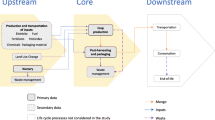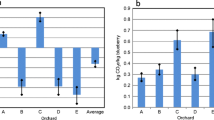Abstract
Understanding the environmental impacts of fruit production will provide fundamental information for policy making of fruit consumption and marketing. This study aims to characterize the carbon footprints of China’s fruit production and to figure out the key greenhouse gas emissions to cut with improved orchard management. Yearly input data of materials and energy in a full life cycle from material production to fruit harvest were obtained via field visits to orchards of five typical fruit types from selected areas of China. Carbon footprint (CF) was assessed with quantifying the greenhouse gas emissions associated with the individual inputs. Farm and product CFs were respectively predicted in terms of land use and of fresh fruit yield. Additionally, product CFs scaled by fruit nutrition value (vitamin C (Vc) content) and by the economic benefit from fruit production were also evaluated. The estimated farm CF ranged from 2.9 to 12.8 t CO2-eq ha−1 across the surveyed orchards, whereas the product CF ranged from 0.07 to 0.7 kg CO2-eq kg−1 fruit. While the mean product CFs of orange and pear were significantly lower than those of apple, banana, and peach, the nutrition-scaled CF of orange (0.5 kg CO2-eq g−1 Vc on average) was significantly lower than others (3.0–5.9 kg CO2-eq g−1 Vc). The income-scaled CF of orange and pear (1.20 and 1.01 kg CO2-eq USD−1, respectively) was higher than apple, banana, and peach (0.87~0.39 kg CO2-eq USD−1). Among the inputs, synthetic nitrogen fertilizer contributed by over 50 % to the total greenhouse gas (GHG) emissions, varying among the fruit types. There were some tradeoffs in product CFs between fruit nutrition value and fruit growers’ income. Low carbon production and consumption policy and marketing mechanism should be developed to cut down carbon emissions from fruit production sector, with balancing the nutrition value, producer’s income, and climate change mitigation.






Similar content being viewed by others
Abbreviations
- CF:
-
Carbon footprint
- LCA:
-
Life cycle assessment
- GHG:
-
Greenhouse gas
References
BP China (2007) Calculator of carbon emission. Available online at http://www.bp.com/sectiongenericarticle.do?categoryId=9011336&contented=7025421
BSI (2011) PAS 2050. Specification for the assessment of the life cycle greenhouse gas emissions of goods and services. British Standards Institute, London, UK
BSI (2012) PAS 2050-1. Assessment of life cycle greenhouse gas emissions from horticultural products. http://shop.bsigroup.com/en/forms/PASs/PAS-2050-1/
Burney JA, Davis SJ, Lobell DB (2010) Greenhouse gas mitigation by agricultural intensification. PNAS 107(26):12052–12057
Chen L, Yan M, Pan G (2011) Evaluation of the carbon footprint of greenhouse vegetable production based on questionnaire survey from Nanjing, China. J Agro Environ Sci 30(9):1791–1796 (in Chinese)
Cheng K, Yan M, Nayak D, Smith P, Pan GX, Zheng JW (2014) Carbon footprint of crop production in China: an analysis of national statistics data. J Agric Sci 153:422–431
Cheng K, Pan G, Luo T, Yan M, Yue Q (2015) Methodology for carbon footprint calculation in crop and livestock production. In: Muthu SS. (ed.) The carbon footprint handbook. CRC Press, 2015. pp 62-84
Cros C, Fourdrin E, Réthoré O (2010) The French initiative on environmental information of mass market products. Int J Life Cycle Assess 15(6):537–539
Department of Rural Social Economical Survey, China’s National Bureau of Statistics (DRSES- NBSC) (2012) China rural statistical yearbook 1993-2011. China Statistics Press, Beijing (in Chinese)
Dubey A, Lal R (2009) Carbon footprint and sustainability of agricultural production systems in Punjab, India, and Ohio, USA. J Crop Improv 23:332–350
Energy Source, China (2009) 7-16 Energy consumption per unit of product in main enterprises that consume much energy, pp 224 (In Chinese)
FAO (2012) Energy-smart food at FAO: an overview. The FAO Technical Papers, available at: http://www.fao.org/docrep/015/an913e/an913e00.htm
FAOSTAT (2013) Statistical database of the food and agricultural organization. Available online at http://faostat3.fao.org/home/index.html
Gan YT, Liang C, Wang XY, Mcconkey B (2011) Lowering carbon footprint of durum wheat by diversifying cropping systems. Field Crop Res 122:199–206
Hillier J, Hawes C, Squire G, Hilton A, Wale S, Smith P (2009) The carbon footprints of food crop production. Int J Agric Sustain 7(2):107–118
IPCC (2006) IPCC guidelines for national greenhouse gas inventories 2006. IPCC/IGES, Kanagawa
IPCC (2007) Changes in atmospheric constituents and in radiative forcing. In: Climate change 2007: the physical science basis, contribution of working group I to the fourth assessment report of the intergovernmental panel on climate change (Eds Solomon S, Qin D, Manning M). Cambridge University Press, Cambridge, United Kingdom/New York, NY, USA
Ju XT, Kou CL, Zhang FS, Christie P (2006) Nitrogen balance and groundwater nitrate contamination: comparison among three intensive cropping systems on the North China Plain. Environ Pollut 143:117–125
Jungbluth N, Büsser S, Frischknecht R, Leuenberger M, Stucki M (2011) Feasibility study for environmental product information based on life cycle approaches; ESU-services Ltd., Fair Consulting in Sustainability: Uster, Switzerland, pp 179. http://www.esu-services.ch/publications/methodology/
Knudsen MT, Meyer-Aurich A, Olesen JE, Chirinda N, Hermansen JE (2014) Carbon footprints of crops from organic and conventional arable crop rotations—using a life cycle assessment approach. J Clean Prod 64:609–618
Liu HT, Chen TB, Zheng GD, Gao D, Lei M (2010a) Comparative analysis of organic and chemical fertilizer production energy consumption, input cost and environmental benefit: sewage sludge composting as example. Ecol Environ Sci 19(4):1000–1003 (in Chinese)
Liu Y, Langer V, Høgh-Jensen H, Egelyng H (2010b) Life cycle assessment of fossil energy use and greenhouse gas emissions in Chinese pear production. J Clean Prod 18:1423–1430
Lu F, Wang XK, Han B, Ouyang ZY, Duan XN, Zheng H (2008) Assessment on the availability of nitrogen fertilization in improving carbon sequestration potential of China’s cropland soil. Chin J Appl Ecol 19(10):2239–2250 (in Chinese)
Michos MC, Mamolos AP, Menexes GC, Tsatsarelis CA, Tsirakoglou VM, Kalburtji KL (2012) Energy inputs, outputs and greenhouse gas emissions in organic, integrated and conventional peach orchards. Ecol Indic 13:22–28
Milà i Canals L, Burnip GM, Cowell SJ (2006) Evaluation of the environmental impacts of apple production using Life Cycle Assessment (LCA): case study in New Zealand. Agric Ecosyst Environ 114:2–4
Mouron P, Nemecek T, Scholz RW, Weber O (2006) Management influence on environmental impacts in an apple production system on Swiss fruit farms: combining life cycle assessment with statistical risk assessment. Agric Ecosyst Environ 114(2-4):311–322
National Bureau of Statistics China (NBSC) (2014) Statistical yearbook 2014. Vol 6. pp 50-157. (in Chinese)
National Development and Reform Commission, the People’s Republic of China (NDRC) (2012) Second national communication on climate change. http://www.ccchina.gov.cn/archiver/ccchinacn/UpFile/Files/Default/20130218142020138656.pdf. (in Chinese)
National Development and Reform Commission, the People’s Republic of China (NDRC) (2014) National strategy planning for climate change mitigation 2014-2020. Beijing, China (in Chinese)
Nemecek T, Dubois D, Huguenin-Elie O, Gaillard G (2011) Life cycle assessment of Swiss farming systems: I. Integrated and organic farming. Agric Syst 104:217–232
Pfister S, Vionnet S, Levova T, Humbert S (2015) Ecoinvent 3: assessing water use in LCA and facilitating water footprinting. Int J Life Cycle Assess. doi:10.1007/s11367-015-0937-0
Schneider UA, Smith P (2009) Energy intensities and greenhouse gas emission mitigation in global agriculture. Energy Efficien 2:195–206
Smith P, Martino D, Cai Z, Gwary D, Janzen H, Kumar P, Mccarl B, Ogle S, O'mara F, Rice C, Scholes B, Sirotenko O, Howden M, Mcallister T, Pan GX, Romanenkov V, Schneider U, Towprayoon S, Wattenbach M, Smith J (2008) Greenhouse gas mitigation in agriculture. Phil Trans R Soc B 363:789–813
State Council of China (SCC) (2014) The development program of Chinese food and nutrition 2014-2020. http://www.gov.cn/zwgk/2014-02/10/content_2581766.htm (In Chinese)
Stoessel F, Juraske R, Pfister S, Hellweg S (2012) Life cycle inventory and carbon and water food print of fruits and vegetables: application to a Swiss retailer. Environ Sci Technol 46(6):3253–3262
Su HR (2012) A strategy investigation on sustainable development of China’s deciduous fruit production. Deciduous Fruit 44(1):1–4 (in Chinese)
Svanes E, Aronsson AKS (2013) Carbon footprint of a Cavendish banana supply chain. Int J Life Cycle Assess 18:1450–1464
Tilman D, Cassman KG, Matson PA, Naylor R, Polasky S (2002) Agricultural sustainability and intensive production practices. Nature 418:671–677
Van Kernebeek HRJ, Oosting SJ, van Ittersum MK, Bikker P, de Boer IJM (2015) Saving land to feed a growing population: consequences for consumption of crop and livestock products. Int J Life Cycle Assess. doi:10.1007/s11367-015-0923-6
Vermeulen SJ, Campbell BM, Ingram JSI (2012) Climate change and food systems. Annu Rev Environ Resour 37:195–222
Wang XY, Tong YA, Liu F, Zhao ZP (2013) Evaluation of the situation of fertilization in apple fields in Shanxi province. Plant Nutr Fertil Sci 19(1):206–213 (in Chinese)
West TO, Marland G (2002) A synthesis of carbon sequestration, carbon emissions, and net carbon flux in agriculture: comparing tillage practices in the United States. Agric Ecosyst Environ 91:217–232
Wiedmann T, Minx J (2008) A definition of ‘carbon footprint’. In: Pertsova CC (ed) Ecological economics research trends, vol 1. Nova, Hauppauge, pp 1–11
Yan M, Cheng K, Luo T, Yan Y, Pan G, Rees RM (2015a) Carbon footprint of grain crop production in China—based on farm survey data. J Clean Prod. doi:10.1016/j.jclepro.2015.05.058
Yan M, Luo T, Bian RJ, Cheng K, Pan GX, Rees RM (2015b) A comparative study on carbon footprint of rice production between household and aggregated farms from Jiangxi, China. Environ Monit Assess. doi:10.1007/s10661-015-4572-9
Yang Y, Wang G, Pan X (2002) China food composition 2002. Peking University Medical Press, Beijing (in Chinese)
Zhang FS, Chen XP, Chen Q et al (2009) Fertilizer application guideline for main crops of China. Chinese Agricultural University Press, Beijing (in Chinese)
Zhang WF, Dou ZX, He P, Ju XT, Powlson D, Chadwick C, Norse D, Lu YL, Zhang Y, Wu L, Chen XP, Cassman KG, Zhang FS (2013) New technologies reduce greenhouse gas emissions from nitrogenous fertilizer in China. PNAS 110(21):8375–8380
Zhao ZP, Tong YA, Liu F, Wang XY, Zeng YJ (2012) Assessment of current conditions of household fertilization of apples in Weibei Plateau. Chin J Eco Agric 20(8):1003–1009 (in Chinese)
Zhao ZP, Gao YM, Liu F, Wang XY, Tong YA (2013) Effects of organic manure application combined with chemical fertilizers on the leaf nutrition, quality and yield of apple. Acta Horticult Sin 40(11):2229–2236 (in Chinese)
Acknowledgments
This work was funded by the Ministry of Finance of China under a subcontract grant from the CDM center and by State Foreign Expert Agency for a “111” project under a grant number B12009. The UK-China cooperation was sponsored with the Priority Academic Program Development of Jiangsu Higher Education Institutions and with the UK-China Sustainable Agriculture Innovation Network (SAIN). We are grateful for the farmers for their patience in the field interview and for the students from the first author’s university who participated in the survey work.
Author information
Authors and Affiliations
Corresponding author
Additional information
Responsible editor: Philippe Garrigues
Highlights
• Both farm and product carbon footprints of five major fruit types from China were assessed using orchard survey data.
• Fruit production had high farm but low product carbon footprint relative to cereal production.
• Orange was lower in product and nutrition-scaled carbon footprint but higher in income-scaled carbon footprint among the others.
• Synthetic nitrogen fertilizer use contributed by over 50 % to the total carbon footprint.
• High fruit yield with low product carbon footprint sustained under high efficiency management.
Electronic supplementary material
Below is the link to the electronic supplementary material.
Table S1
(XLSX 18 kb)
Rights and permissions
About this article
Cite this article
Yan, M., Cheng, K., Yue, Q. et al. Farm and product carbon footprints of China’s fruit production—life cycle inventory of representative orchards of five major fruits. Environ Sci Pollut Res 23, 4681–4691 (2016). https://doi.org/10.1007/s11356-015-5670-5
Received:
Accepted:
Published:
Issue Date:
DOI: https://doi.org/10.1007/s11356-015-5670-5




